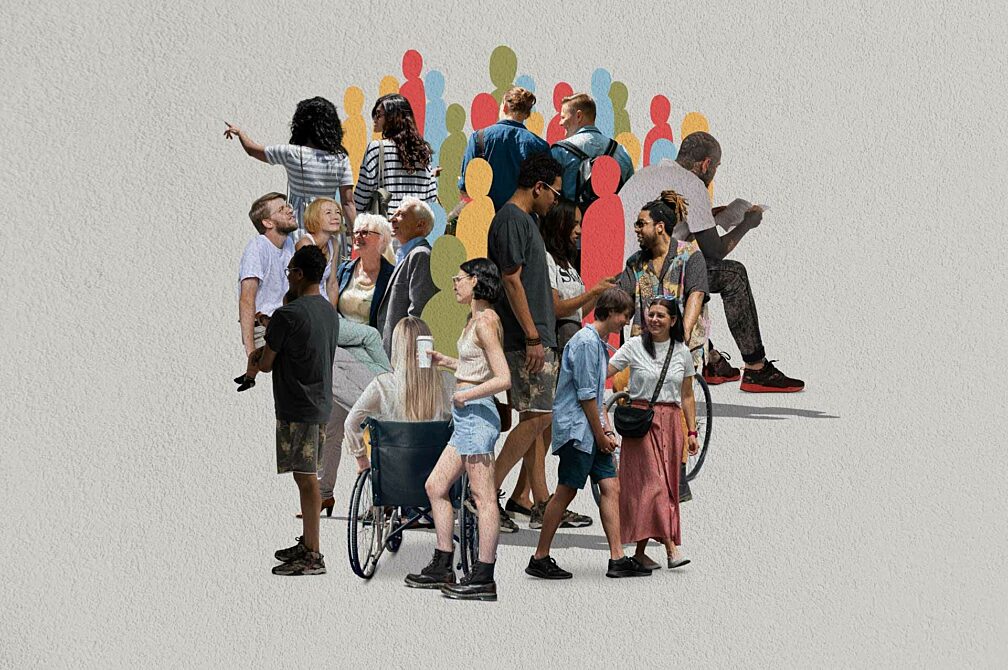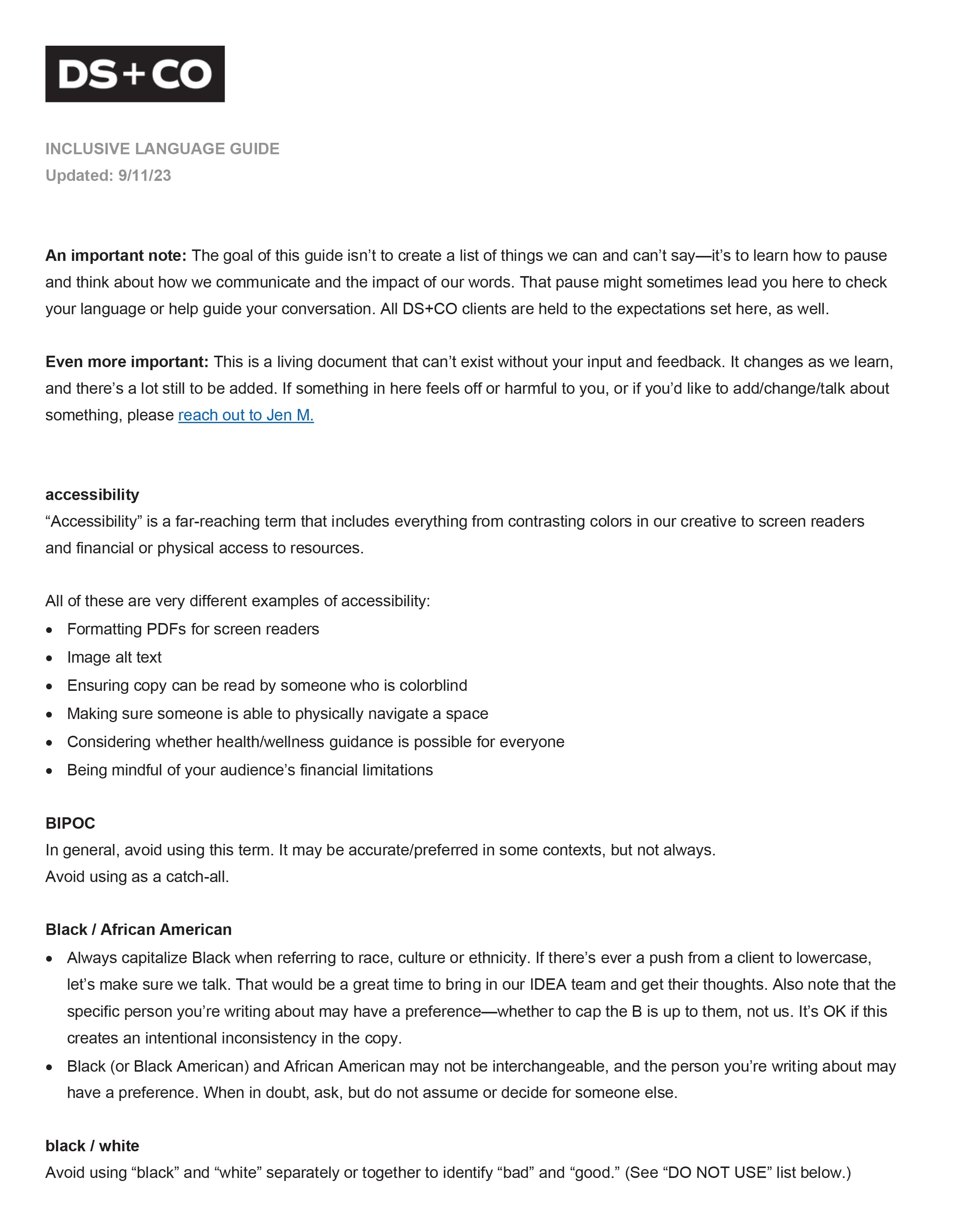Blog
DEI + Culture

Inclusive marketing is here to stay
If your organization’s been paying attention to corporate responsibility—and specifically corporate diversity initiatives—over the past few years, I have some stats that probably won’t be much of a surprise.
In 2021, 83% of companies surveyed by World at Work had DEI initiatives in place. And in 2023, employees are as invested as ever:

When it comes to what people expect from their employer, these big numbers show that workplace DEI isn’t going anywhere. That’s especially true as more Gen Z-ers enter the workforce: A whopping 83% say they consider an employer’s commitment to diversity and inclusion when deciding where to work.
So a recent NPR story about a sharp decline in the number of DEI-related roles workplaces are hiring for caught my attention. With such strong support, why are DEI jobs disappearing? NPR points to the slowing economy, but with so much employee interest, I’m optimistic that much of the work is being picked up by people across organizations, making it a more integrated part of day-to-day business.
A 2023 Benevity Labs report might back that up. When asked who cares the most about DEI at their workplace, 46% of employees said they do and only 13% pointed to leadership. Benevity’s key takeaway?
“Corporate leaders should think twice before curtailing resources for DEI initiatives this year. Employees place high value on these initiatives and want employers to be more engaged with DEI efforts moving forward—regardless of the broader economic picture.”
Your inclusive marketing campaign still matters
We know two things for sure: A slowing economy means tighter budgets, and the majority of workers care about their employer’s commitment to DEI. So how can your company continue to show its investment if it can’t, well, make that investment?
At DS+CO, we don’t have one dedicated DEI role. Instead, we have a team of people from across the agency who contribute to our DEI work. Because that team represents so many different departments, we’re able to show our commitment in two important ways: Internally, by continuing to invest, listen and learn. And externally, by proving it through more robust, inclusive work.
Our Managing Director of Communications Nadine General is a core member of our DEI team, too, ensuring we follow through on all levels.
“From engaging partners to ensure all voices are at the table, to panel reviews on work before it goes out the door, to establishing a dedicated DEI committee with a strategic plan that’s measured and held up to the agency to ensure the work is prioritized and delivered on, we put a 360-degree lens on our DEI efforts.
That impacts our clients and our community, and it attracts talent that’s also committed.”
For our clients, that also means every piece of work that moves through DS+CO is viewed through a critical lens and an intentional review process. It puts us in a unique (and honestly, fulfilling) position to help create campaigns that reach far beyond our own brand. The numbers speak for themselves: Consumers care about DEI and it impacts their decisions. As marketers, we need to show them we care, too.
Building DEI from the inside out
You’ve heard the phrase “it starts at home,” and that definitely applies here.
The DEI work your organization does internally is reflected in the work you show externally—from your marketing campaigns and brand reputation to the clients and potential employees you attract.
Take Target, for example. The brand established its Diversity Steering Committee all the way back in 2003, then introduced more diverse ads and then took it a step further by introducing sensory-friendly adaptive clothing for kids. And they’ve kept building for 20 years, proving that your first steps internally set the stage for everything people see about your brand later. What starts at home doesn’t end at home.
At DS+CO, our commitment to action was our first step, and we’ve worked hard to build on our efforts since then. If you’re a DS+CO client, many of those internal initiatives are already a part of your work as our partner. Here’s a look at some things we do—and you can, too—to keep the focus on DEI at your company.
Create an inclusive language guide
This is a living, evolving document that helps your team be more mindful of their words. It should include advice for how to talk or write about different topics (like race, religion, gender), words to avoid and tips for talking through what I call “gray area” words, where context and audience might change how they’re perceived. And when I say evolving, I mean evolving: At DS+CO, almost everything in the first iteration of our guide has been updated or replaced over the past few years.


Lean on your experts
Over the past year, I’ve met with school communicators, public relations professionals and mental-health organizations to talk about how they can start shifting their language and build their own guide that works for them. It’s one of my favorite DS+CO initiatives, because it pushes our DEI work into the community and helps others. But it works in reverse, too: If you find you’re struggling to get an initiative off the ground, invite people into your organization who can help educate your team. Wherever you’re based, your community is likely a great resource for diverse opinions, expertise and guidance.
Build a review community
Speaking of leaning on your experts, those same people can help you understand your own work more clearly, offering opinions you might not have in your own organization. At DS+CO, we call this our IDEA panel, and it helps us ensure we’re capturing any unconscious biases in our work. Each panel is made up of community members who are invited to share their perspectives on the work we’ve asked them to review. They help us understand not just where we’re hitting the mark, but where we aren’t. Once you’ve uncovered your blind spots, sharing those learnings with your team will set you up for even stronger work going forward.

Share your knowledge
If you don’t already have DEI-related experts on your team, it’s likely you do have people who are interested in training opportunities that can be passed along to the rest of your organization. Invest in these people. I’ll use myself as an example: DS+CO supported my interest in inclusive language, and one of the things that eventually came out of my training is regular DEI language tips during our all-agency meeting. The key is to keep what you’re sharing relatable and topical, at a level that will resonate with people who aren’t experts—yet.
Keep your team updated
It’s hard for your team to feel invested in something if they don’t know much about it. So share what you’re doing! Every quarter, we dedicate one of our all-agency meetings to DEI-related education and updates. We’ve welcomed presenters to talk about things like pronouns and ageism, and we’ve used the time to share what we’ve learned about intersectionality. Our DEI team also meets monthly to check in on goals, talk about how our agency is responding to current events or observances, and share learnings with each other—and all are welcome to suggest topics for these quarterly deep-dives.
Create internships + partnerships
In an industry that’s historically (and currently) mostly white, it’s critical that marketers continue providing entry points. That’s true for plenty of other fields, as well. You can’t snap your fingers and create a more diverse team, but you can offer opportunities and relationships that start bridging the gap. This year, for example, DS+CO hosted two interns through the BLAC (Building Leaders and Creatives) program, which helps bring more young Black professionals into the advertising field.

Next steps in your DEI journey
You don’t need to do everything on that list above, and you certainly don’t have to do only those things. People often tell me they want to do more but don’t know where to get started. As an editor, it’s a little self-serving to say language is the first step, but it’s true. The words we use are a real, tangible and immediate way to start making a difference. And to that, I point you toward starting an inclusive language guide like the one I mentioned above.
As you continue to move forward on your company’s DEI journey—or even if you’re just getting started—be sure to keep an eye on emerging trends that could affect your industry.
- Do you use AI-generated images or copy?
- Who’s ensuring that content is accurate, intentional and thoughtful?
- Are you hiring a lot of recent graduates who are entering the workforce with fresh perspectives? If so, who’s bridging the gap between current policies and their expectations?
These are important questions, and only your team (or your marketing partner) can answer them. Having people in place who are educated, trained and invested will ensure you can address these questions as they come up and feel confident in the response you put in place.
Your employees are invested in your DEI work. Whether you’re carving out the space for a formal role or are looking to them to lead the charge, what you do internally makes a big difference in how your customers are seeing your brand externally. It’s 2023, and DEI matters more than ever.
If you're interested in seeing our full inclusive style guide, send me an email at jen_moritz@dixonschwabl.com and I'll share it with you.
Jen Moritz
Jen Moritz is DS+CO’s senior editor + inclusive language specialist with a passion for the right words and thoughtful, intentional language.